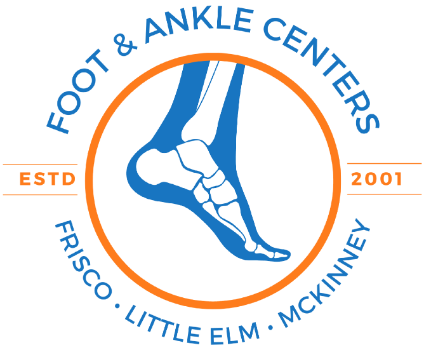What Is Ankle Arthritis? at Foot & Ankle Centers
Tuesday, July 29, 2025 | By: Foot & Ankle Centers of Frisco, Little Elm, McKinney
Ankle arthritis affects millions, causing pain, swelling, and stiffness that often worsen before being noticed. It can stem from wear-and-tear, injuries, or autoimmune diseases like rheumatoid arthritis, impacting mobility and daily life if untreated. Dr. Knapp, Dr. Tavakoli, and Dr. Treleven at Foot & Ankle Centers in Frisco, Little Elm, and McKinney provide expert care to help you understand and manage ankle arthritis. This guide covers the types, causes, symptoms, and treatments of ankle arthritis to help you find relief and improve your quality of life.
What is Ankle Arthritis?
Ankle arthritis is a condition characterized by inflammation of the ankle joint, which leads to the breakdown of cartilage. This degeneration causes the bones to rub together, resulting in pain and stiffness. There are several forms of arthritis that can affect the ankle, including osteoarthritis, rheumatoid arthritis, and post-traumatic arthritis. Each of these conditions has its own unique causes and characteristics.
Types of Ankle Arthritis
- Osteoarthritis: Often referred to as wear-and-tear arthritis, osteoarthritis occurs when the cartilage protecting the ends of the bones deteriorates. It is the most common type of arthritis affecting the ankle. This condition is usually seen in older adults and can worsen with age.
- Rheumatoid Arthritis: This is an autoimmune condition where the immune system mistakenly attacks the synovium, the lining of the membranes that surround your joints. Persistent inflammation can lead to chronic pain and significant joint damage.
- Post-Traumatic Arthritis: This type occurs after an injury to the ankle, such as fractures or serious sprains. Damage to the cartilage during the injury can predispose individuals to develop arthritis in the affected joint.
What Causes Ankle Arthritis?
According to the team at Foot & Ankle Centers the primary causes of ankle arthritis include:
- Wear and Tear: Age is a significant factor. As we age, the cartilage wears down, leading to osteoarthritis.
- Old Injuries: Prior injuries can contribute to post-traumatic arthritis, particularly in individuals who have suffered severe ankle sprains or fractures.
- Autoimmune Conditions: Diseases like rheumatoid arthritis can develop when the body’s immune system attacks healthy joint tissues.
Symptoms of Ankle Arthritis
Ankle arthritis can manifest itself through various symptoms, including:
- Pain in the ankle joint, especially during movement or after periods of inactivity.
- Swelling around the ankle.
- Stiffness, particularly in the mornings or after sitting for long periods.
- Limited range of motion, making daily activities difficult.
- A crackling or popping sensation when moving the ankle.
Risk Factors for Developing Ankle Arthritis
Several factors can increase your risk of developing ankle arthritis, including:
- Obesity: Extra weight puts additional stress on weight-bearing joints, including the ankle.
- Genetics: A family history of arthritis can increase your risk.
- Certain Occupations: Jobs that require repetitive ankle movements or heavy lifting can also raise your chances of developing arthritis.
How is Ankle Arthritis Diagnosed?
If you suspect that you have ankle arthritis, it’s vital to consult a healthcare professional for an accurate diagnosis. The comprehensive diagnostic process at Foot & Ankle Centers in Frisco, Little Elm, and McKinney may include:
1. Medical History: Your doctor will review your medical history and symptoms.
2. Physical Examination: A thorough physical exam will help assess the extent of inflammation and range of motion.
3. Imaging Tests: X-rays or MRI scans can provide detailed images of the ankle joint to identify cartilage loss, bone spurs, or other damage.
Treatment Options for Ankle Arthritis
Early intervention is key to managing ankle arthritis effectively. Treatment typically focuses on relieving pain and improving function. Some common approaches include:
- Lifestyle Modifications: Weight loss, low-impact exercises, and physical therapy can help strengthen the muscles around the ankle and improve mobility.
- Medications: Anti-inflammatory medications, such as NSAIDs, can reduce pain and swelling.
- Injections: Corticosteroid injections can provide temporary relief from inflammation, while hyaluronic acid injections may help lubricate the joint.
- Bracing: Wearing a brace can help stabilize the ankle and provide support during activities.
- Surgery: In severe cases, surgical options like ankle arthroscopy, arthrodesis, or total ankle replacement may be necessary to alleviate pain and restore function.
Living with Ankle Arthritis
Managing ankle arthritis requires ongoing care and lifestyle adjustments. Here are some strategies to help you live well with the condition:
- Stay Active: Engage in low-impact exercises such as swimming or cycling to maintain strength and flexibility without exacerbating your symptoms.
- Diet and Nutrition: Incorporate anti-inflammatory foods into your diet, and maintain a healthy weight to relieve joint stress.
- Physical Therapy: Regular sessions with a physical therapist can provide tailored exercises for strength training and mobility.
- Mindfulness and Support: Consider joining a support group or practicing mindfulness techniques to cope with the emotional burden of chronic pain.
Moving Forward with Ankle Arthritis
Dealing with ankle arthritis can be challenging, but understanding the condition empowers you to take control of your health. Dr. Knapp, Dr. Tavakoli, and Dr. Treleven at Foot & Ankle Centers in Frisco, Little Elm, and McKinney provide expert and compassionate care to help you recognize early signs and seek timely treatment. With their guidance, lifestyle changes, medical interventions, and active management become vital steps toward reducing pain, improving mobility, and living a fulfilling life with ankle arthritis.


Leave a comment
0 Comments